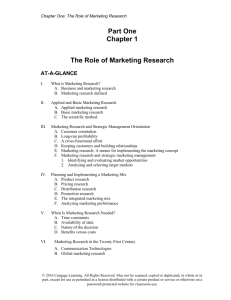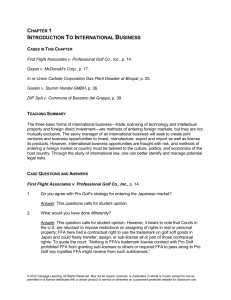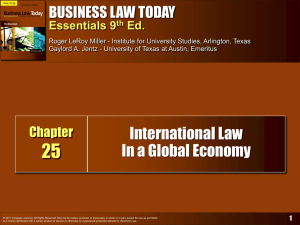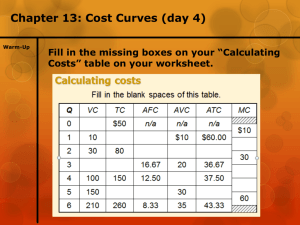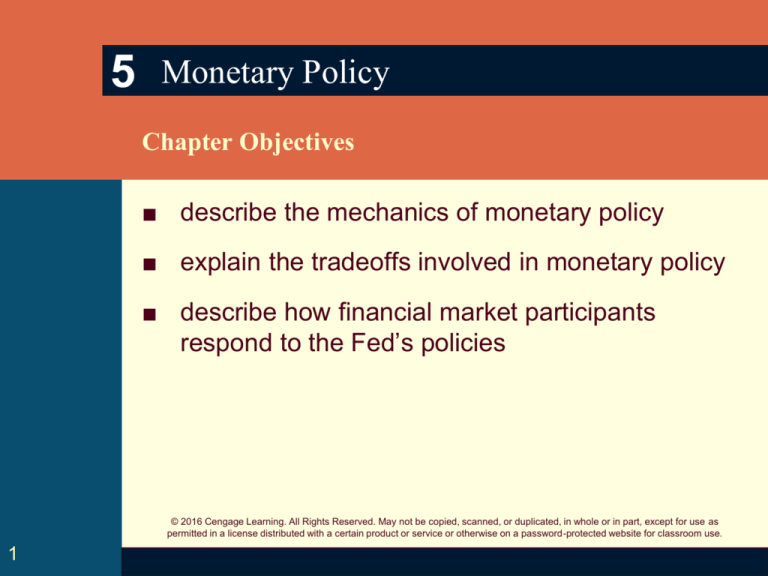
5
Monetary Policy
Chapter Objectives
■ describe the mechanics of monetary policy
■ explain the tradeoffs involved in monetary policy
■ describe how financial market participants
respond to the Fed’s policies
© 2016 Cengage Learning. All Rights Reserved. May not be copied, scanned, or duplicated, in whole or in part, except for use as
permitted in a license distributed with a certain product or service or otherwise on a password-protected website for classroom use.
1
Mechanics of Monetary Policy
Monitoring Indicators of Economic Growth:
The Fed monitors indicators of economic growth:
2
GDP - measures the total value of goods and services
produced during a specific period
National Income - the total income earned by firms and
individual employees during a specific period
Unemployment rate - maintain a low of unemployment rate
in the U.S.
Other indexes - Industrial production index, a retail sales
index, and a home sales index, and others.
© 2016 Cengage Learning. All Rights Reserved. May not be copied, scanned, or duplicated, in whole or in part, except for use as
permitted in a license distributed with a certain product or service or otherwise on a password-protected website for classroom use.
Mechanics of Monetary Policy
Monitoring Indicators of Inflation
Producer and consumer price indexes: Producer price index
represents prices at the wholesale level, and the consumer price
index represents prices paid by consumers (retail level).
Other inflation indicators
Wage rates are periodically reported in various regions.
Oil prices can signal future inflation because they affect the
costs of some forms of production as well as transportation
costs and the prices paid by consumers for gasoline.
The price of gold is closely monitored because gold prices tend
to move in tandem with inflation.
3
© 2016 Cengage Learning. All Rights Reserved. May not be copied, scanned, or duplicated, in whole or in part, except for use as
permitted in a license distributed with a certain product or service or otherwise on a password-protected website for classroom use.
Implementing Monetary Policy
Once the Federal Open Market Committee assesses
economic conditions, it can identify its main concerns
about the economy and determine the proper
monetary policy that would alleviate its concerns.
Monetary policy changes the money supply in order
to influence interest rates.
4
© 2016 Cengage Learning. All Rights Reserved. May not be copied, scanned, or duplicated, in whole or in part, except for use as
permitted in a license distributed with a certain product or service or otherwise on a password-protected website for classroom use.
Implementing Monetary Policy
Effects of a Stimulative Monetary Policy
With a stimulative monetary policy, the Fed
increases the supply of funds in the banking
system, which can increase the level of business
investment, and hence aggregate spending in the
economy.
5
© 2016 Cengage Learning. All Rights Reserved. May not be copied, scanned, or duplicated, in whole or in part, except for use as
permitted in a license distributed with a certain product or service or otherwise on a password-protected website for classroom use.
Exhibit 5.2 Effects of an Increased Money Supply
6
© 2016 Cengage Learning. All Rights Reserved. May not be copied, scanned, or duplicated, in whole or in part, except for use as
permitted in a license distributed with a certain product or service or otherwise on a password-protected website for classroom use.
Implementing Monetary Policy
Effects of a Stimulative Monetary Policy (cont.)
7
Impact on interest rates - The quantity of loanable funds
supplied exceeds the quantity of loanable funds demanded.
The interest rate will decline to equilibrium.
Logic behind the impact on interest rates - The depository
institutions experience an increase in supply of funds.
Therefore, they borrow less funds or provide more short-term
loans at lower interest rates.
© 2016 Cengage Learning. All Rights Reserved. May not be copied, scanned, or duplicated, in whole or in part, except for use as
permitted in a license distributed with a certain product or service or otherwise on a password-protected website for classroom use.
Implementing Monetary Policy
Effects of a Stimulative Monetary Policy (cont.)
8
Logic behind the effects of business cost of debt - As
business cost of debt decreases, firms implement more
projects and spend more money. This results in more income
to individuals or other firms which allows more people to
invest in the original company.
Effects on business cost of equity - The firms cost of equity
is positively related to the risk-free rate. Lower risk-free rate =
Lower cost of equity
© 2016 Cengage Learning. All Rights Reserved. May not be copied, scanned, or duplicated, in whole or in part, except for use as
permitted in a license distributed with a certain product or service or otherwise on a password-protected website for classroom use.
Implementing Monetary Policy
Effects of a Stimulative Monetary Policy (cont.)
Summary of Effects
9
Effects on the Treasury (risk-free) rate influences cost of
debt and cost of equity. (Exhibit 5.3)
Cost of capital is reduced, reducing required return on cost
of products.
Encourages firms to spend more money, higher more
employees.
© 2016 Cengage Learning. All Rights Reserved. May not be copied, scanned, or duplicated, in whole or in part, except for use as
permitted in a license distributed with a certain product or service or otherwise on a password-protected website for classroom use.
Exhibit 5.3 How the Fed Can Stimulate the Economy
10
© 2016 Cengage Learning. All Rights Reserved. May not be copied, scanned, or duplicated, in whole or in part, except for use as
permitted in a license distributed with a certain product or service or otherwise on a password-protected website for classroom use.
Implementing Monetary Policy
Effects of Restrictive Monetary Policy (Exhibit 5.5)
11
Increasing risk-free interest rate, increases corporate
cost of financing, therefore decreasing the level of
business investment.
As economic growth is slowed, inflationary pressure may
be reduced.
© 2016 Cengage Learning. All Rights Reserved. May not be copied, scanned, or duplicated, in whole or in part, except for use as
permitted in a license distributed with a certain product or service or otherwise on a password-protected website for classroom use.
Exhibit 5.5 Effects of a Reduced Money Supply
12
© 2016 Cengage Learning. All Rights Reserved. May not be copied, scanned, or duplicated, in whole or in part, except for use as
permitted in a license distributed with a certain product or service or otherwise on a password-protected website for classroom use.
Implementing Monetary Policy
Summary of Monetary Policy Effects
Fed can affect economic conditions through its influence
on the supply of loanable funds. (Exhibit 5.6)
Lagged Effects of Monetary Policy:
13
Recognition lag - lag between the time a problem arises and the
time it is recognized
Implementation lag - lag from the time a serious problem is
recognized until the time the Fed implements a policy to resolve
that problem
Impact lag - lag until the policy has its full impact on the
economy
© 2016 Cengage Learning. All Rights Reserved. May not be copied, scanned, or duplicated, in whole or in part, except for use as
permitted in a license distributed with a certain product or service or otherwise on a password-protected website for classroom use.
Exhibit 5.6 How Monetary Policy Can Affect Economic
Conditions
14
© 2016 Cengage Learning. All Rights Reserved. May not be copied, scanned, or duplicated, in whole or in part, except for use as
permitted in a license distributed with a certain product or service or otherwise on a password-protected website for classroom use.
Tradeoff in Monetary Policy
Ideally, the Fed would like to achieve both a very low level of
unemployment and a very low level of inflation in the United
States.
15
Inverse relationship between inflation and
unemployment.
Strong economic conditions: high inflation, low unemployment
Weak economic conditions: low inflation, high unemployment
Historical data on annual inflation and unemployment rates
show that when one of these problems worsens, the other does
not automatically improve.
© 2016 Cengage Learning. All Rights Reserved. May not be copied, scanned, or duplicated, in whole or in part, except for use as
permitted in a license distributed with a certain product or service or otherwise on a password-protected website for classroom use.
Exhibit 5.7 Trade-off between Reducing Inflation and
Unemployment
16
© 2016 Cengage Learning. All Rights Reserved. May not be copied, scanned, or duplicated, in whole or in part, except for use as
permitted in a license distributed with a certain product or service or otherwise on a password-protected website for classroom use.
Monitoring the Impact of Monetary Policy
Impact on Financial Institutions
17
When interest rates rise, the cost of funds for financial
institutions rises faster than the return they receive.
Financial institutions such as commercial banks, bond mutual
funds, insurance companies, and pension funds maintain large
portfolios of bonds, so their portfolios are adversely affected
when the Fed raises interest rates.
Stock mutual funds, insurance companies, and pension funds
maintain large portfolios of stocks, and their stock portfolios are
also indirectly affected by changes in interest rates.
© 2016 Cengage Learning. All Rights Reserved. May not be copied, scanned, or duplicated, in whole or in part, except for use as
permitted in a license distributed with a certain product or service or otherwise on a password-protected website for classroom use.
Homework Assignment 4
Chapter 4: Questions and Applications 2, 3, 9.
Chapter 5: Questions and Applications 3, 8,
18
© 2016 Cengage Learning. All Rights Reserved. May not be copied, scanned, or duplicated, in whole or in part, except for use as
permitted in a license distributed with a certain product or service or otherwise on a password-protected website for classroom use.




